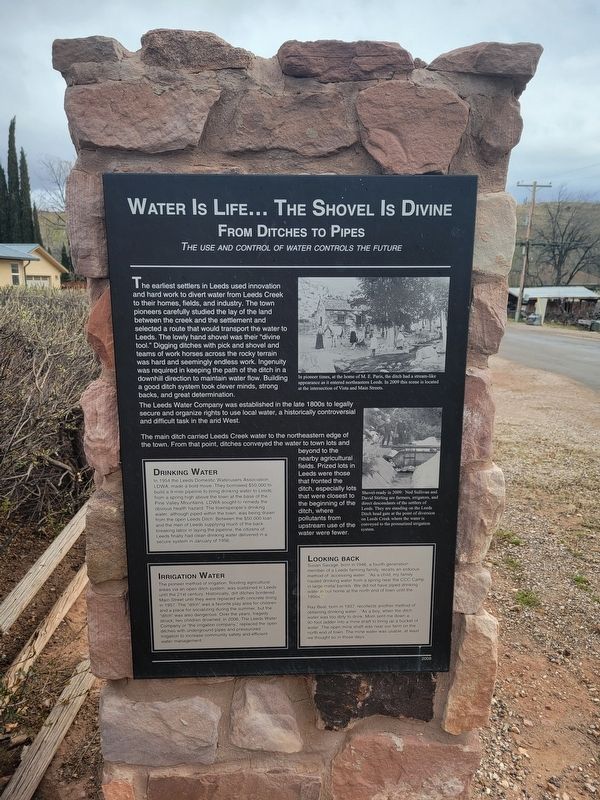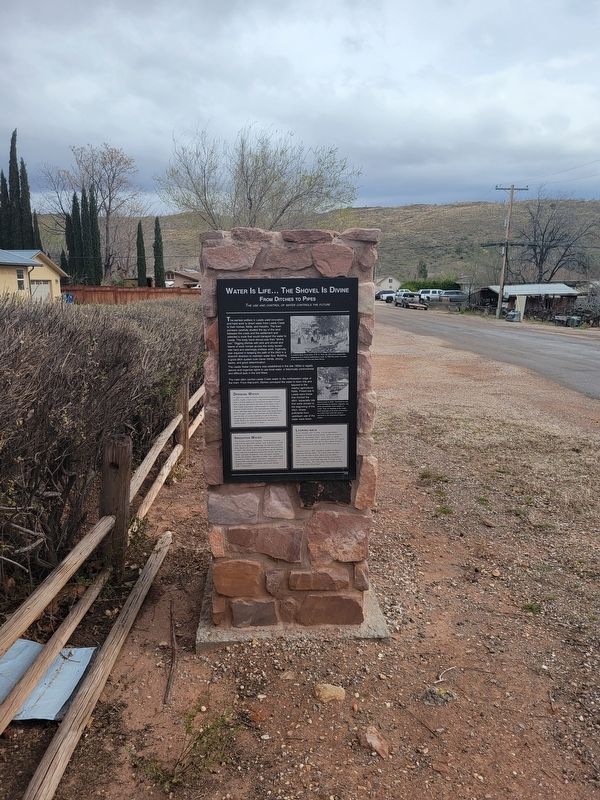Leeds in Washington County, Utah — The American Mountains (Southwest)
Water Is Life...The Shovel Is Divine
From Ditches to Pipes
The Use and Control of Water Controls the Future
The earliest settlers in Leeds used innovation and hard work to divert water from Leeds Creek to their homes, fields, and industry. The town pioneers carefully studied the lay of the land between the creek and the settlement and selected a route that would transport the water to Leeds. The lowly hand shovel was their "divine tool." Digging ditches with pick and shovel and teams of work horses across the rocky terrain was hard and seemingly endless work. Ingenuity was required in keeping the path of the ditch in a downhill direction to maintain water flow. Building a good ditch system took clever minds, strong backs, and great determination.
The Leeds Water Company was established in the late 1800s to legally secure and organize rights to use local water, a historically controversial and difficult task in the arid West.
The main ditch carried Leeds Creek water to the northeastern edge of the town. From that point, ditches conveyed the water to town lots and beyond to the nearby agricultural fields. Prized lots in Leeds were those that fronted the ditch, especially lots that were closest to the beginning of the ditch, where pollutants from upstream use of the water were fewer.
Drinking Water
In 1954 the Leeds Domestic Waterusers Association, LDWA, made a bold move. They borrowed $50,000 to build a 9-mile pipeline to bring drinking water to Leeds from a spring high above the town at the base of the Pine Valley Mountains. LDWA sought to remedy the obvious health bazard. The townspeople's drinking water, althought piped within the town, was being drawn from the open Leeds Ditch. Between the $50,000 loan and the men of Leeds supplying much of th eback-breaking labor in laying the pipeline, the citizens of Leeds finally had clean drinking watre delivered in a secure system in January of 1956.
Irrigation Water
The pioneer method of irrigation, flooding agricultural areas via an open ditch system, was sustained in Leeds until the 21st centure. Historically, dirt ditches bordred Main Street until they were replaced with concrete lining in 1957. The "ditch" was a favorite play area for children and a place for socializing during hte summer, but the "ditch" was also dangerous. Over the years, tragedy struck; two children drowned. In 2006, the Leeds water Cpany or "the irrication company," replaced the open ditches with underground pipes and pressurized irrigation to increase community safety and efficient water management.
Looking Back
Susan Savage, born in 1946, a fourth generation member of a Leeds farming family, recalls an arduous method of accessing water, "As a child, my family hauled drinking water from a spring near the CCC Camp in large metal barrels. We did not have piped drinking water in our home at the north end of town until the 1950s?"
Ray Beal, born in 1937, recollects another method of obtaining drinking water. "As a boy, when the ditch water was too dirty to drink, Mom sent me down a 90-foot ladder into a mine shaft to bring up a bucked of water. The open mine shaft was near our farm on the north end of town. The mine water was was usable; at least we thought so in those days."
Topics. This historical marker is listed in these topic lists: Agriculture • Natural Resources • Settlements & Settlers. A significant historical month for this entry is January 1956.
Location. 37° 14.155′ N, 113° 21.768′ W. Marker is in Leeds, Utah, in Washington County. Marker is at the intersection of North Main Street and West Center Street, on the left when traveling east on North Main Street. Touch for map. Marker is in this post office area: Leeds UT 84746, United States of America. Touch for directions.
Other nearby markers. At least 8 other markers are within walking distance of this marker. The Sarah Ann and William Stirling Home (a few steps from this marker); The Leeds Tithing Office (within shouting distance of this marker); From Native American Trail to Interstate Exit (within shouting distance of this marker); Civilian Conservation Corps, Leeds, Utah (approx. ¼ mile away); "They Were Poor, Hungry, and They Built to Last" (approx. ¼ mile away); Leeds CCC Camp (approx. ¼ mile away); Leeds Historic CCC Camp (approx. ¼ mile away); From Schoolhouse to Town Hall (approx. 0.3 miles away). Touch for a list and map of all markers in Leeds.
Credits. This page was last revised on April 1, 2024. It was originally submitted on March 18, 2024, by Jeremy Snow of Cedar City, Utah. This page has been viewed 45 times since then. Photos: 1, 2. submitted on March 18, 2024, by Jeremy Snow of Cedar City, Utah. • Andrew Ruppenstein was the editor who published this page.

